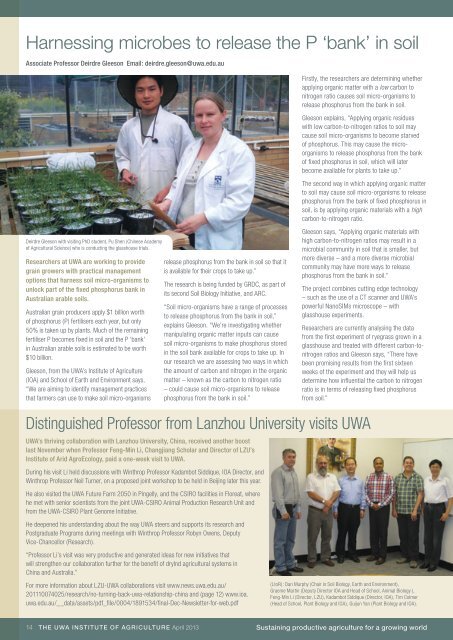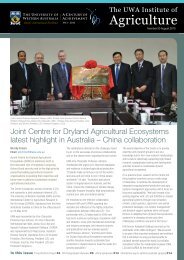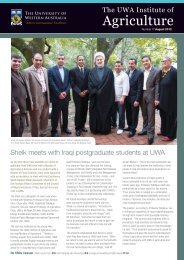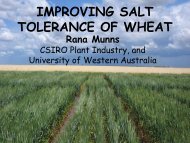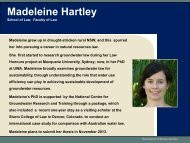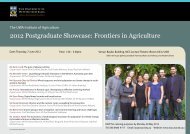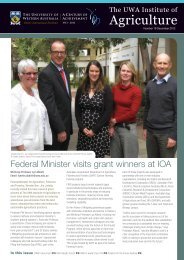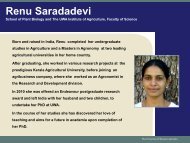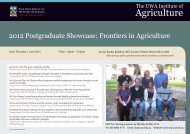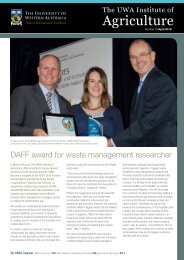Download - The UWA Institute of Agriculture - The University of ...
Download - The UWA Institute of Agriculture - The University of ...
Download - The UWA Institute of Agriculture - The University of ...
Create successful ePaper yourself
Turn your PDF publications into a flip-book with our unique Google optimized e-Paper software.
Harnessing microbes to release the P ‘bank’ in soil<br />
Associate Pr<strong>of</strong>essor Deirdre Gleeson Email: deirdre.gleeson@uwa.edu.au<br />
Firstly, the researchers are determining whether<br />
applying organic matter with a low carbon to<br />
nitrogen ratio causes soil micro-organisms to<br />
release phosphorus from the bank in soil.<br />
Gleeson explains, “Applying organic residues<br />
with low carbon-to-nitrogen ratios to soil may<br />
cause soil micro-organisms to become starved<br />
<strong>of</strong> phosphorus. This may cause the microorganisms<br />
to release phosphorus from the bank<br />
<strong>of</strong> fixed phosphorus in soil, which will later<br />
become available for plants to take up.”<br />
<strong>The</strong> second way in which applying organic matter<br />
to soil may cause soil micro-organisms to release<br />
phosphorus from the bank <strong>of</strong> fixed phosphiorus in<br />
soil, is by applying organic materials with a high<br />
carbon-to-nitrogen ratio.<br />
Deirdre Gleeson with visiting PhD student, Pu Shen (Chinese Academy<br />
<strong>of</strong> Agricultural Science) who is conducting the glasshouse trials.<br />
Researchers at <strong>UWA</strong> are working to provide<br />
grain growers with practical management<br />
options that harness soil micro-organisms to<br />
unlock part <strong>of</strong> the fixed phosphorus bank in<br />
Australian arable soils.<br />
Australian grain producers apply $1 billion worth<br />
<strong>of</strong> phosphorus (P) fertilisers each year, but only<br />
50% is taken up by plants. Much <strong>of</strong> the remaining<br />
fertiliser P becomes fixed in soil and the P ‘bank’<br />
in Australian arable soils is estimated to be worth<br />
$10 billion.<br />
Gleeson, from the <strong>UWA</strong>’s <strong>Institute</strong> <strong>of</strong> <strong>Agriculture</strong><br />
(IOA) and School <strong>of</strong> Earth and Environment says,<br />
“We are aiming to identify management practices<br />
that farmers can use to make soil micro-organisms<br />
release phosphorus from the bank in soil so that it<br />
is available for their crops to take up.”<br />
<strong>The</strong> research is being funded by GRDC, as part <strong>of</strong><br />
its second Soil Biology Initiative, and ARC.<br />
“Soil micro-organisms have a range <strong>of</strong> processes<br />
to release phosphorus from the bank in soil,”<br />
explains Gleeson. “We’re investigating whether<br />
manipulating organic matter inputs can cause<br />
soil micro-organisms to make phosphorus stored<br />
in the soil bank available for crops to take up. In<br />
our research we are assessing two ways in which<br />
the amount <strong>of</strong> carbon and nitrogen in the organic<br />
matter – known as the carbon to nitrogen ratio<br />
– could cause soil micro-organisms to release<br />
phosphorus from the bank in soil.”<br />
Gleeson says, “Applying organic materials with<br />
high carbon-to-nitrogen ratios may result in a<br />
microbial community in soil that is smaller, but<br />
more diverse – and a more diverse microbial<br />
community may have more ways to release<br />
phosphorus from the bank in soil.”<br />
<strong>The</strong> project combines cutting edge technology<br />
– such as the use <strong>of</strong> a CT scanner and <strong>UWA</strong>’s<br />
powerful NanoSIMs microscope – with<br />
glasshouse experiments.<br />
Researchers are currently analysing the data<br />
from the first experiment <strong>of</strong> ryegrass grown in a<br />
glasshouse and treated with different carbon-tonitrogen<br />
ratios and Gleeson says, “<strong>The</strong>re have<br />
been promising results from the first sixteen<br />
weeks <strong>of</strong> the experiment and they will help us<br />
determine how influential the carbon to nitrogen<br />
ratio is in terms <strong>of</strong> releasing fixed phosphorus<br />
from soil.”<br />
Distinguished Pr<strong>of</strong>essor from Lanzhou <strong>University</strong> visits <strong>UWA</strong><br />
<strong>UWA</strong>’s thriving collaboration with Lanzhou <strong>University</strong>, China, received another boost<br />
last November when Pr<strong>of</strong>essor Feng-Min Li, Changjiang Scholar and Director <strong>of</strong> LZU’s<br />
<strong>Institute</strong> <strong>of</strong> Arid AgroEcology, paid a one-week visit to <strong>UWA</strong>.<br />
During his visit Li held discussions with Winthrop Pr<strong>of</strong>essor Kadambot Siddique, IOA Director, and<br />
Winthrop Pr<strong>of</strong>essor Neil Turner, on a proposed joint workshop to be held in Beijing later this year.<br />
He also visited the <strong>UWA</strong> Future Farm 2050 in Pingelly, and the CSIRO facilities in Floreat, where<br />
he met with senior scientists from the joint <strong>UWA</strong>-CSIRO Animal Production Research Unit and<br />
from the <strong>UWA</strong>-CSIRO Plant Genome Initiative.<br />
He deepened his understanding about the way <strong>UWA</strong> steers and supports its research and<br />
Postgraduate Programs during meetings with Winthrop Pr<strong>of</strong>essor Robyn Owens, Deputy<br />
Vice‐Chancellor (Research).<br />
“Pr<strong>of</strong>essor Li’s visit was very productive and generated ideas for new initiatives that<br />
will strengthen our collaboration further for the benefit <strong>of</strong> drylnd agricultural systems in<br />
China and Australia.”<br />
For more information about LZU-<strong>UWA</strong> collaborations visit www.news.uwa.edu.au/<br />
201110074025/research/no-turning-back-uwa-relationship-china and (page 12) www.ioa.<br />
uwa.edu.au/__data/assets/pdf_file/0004/1891534/final-Dec-Newsletter-for-web.pdf<br />
(LtoR): Dan Murphy (Chair in Soil Biology, Earth and Environment),<br />
Graeme Martin (Deputy Director IOA and Head <strong>of</strong> School, Animal Biology ),<br />
Feng-Min Li (Director, LZU), Kadambot Siddique (Director, IOA), Tim Colmer<br />
(Head <strong>of</strong> School, Plant Biology and IOA), Guijun Yan (Plant Biology and IOA).<br />
14 THE <strong>UWA</strong> institute <strong>of</strong> agriculture April 2013 Sustaining productive agriculture for a growing world


